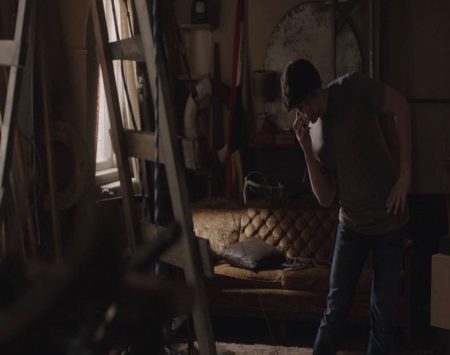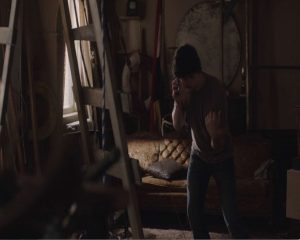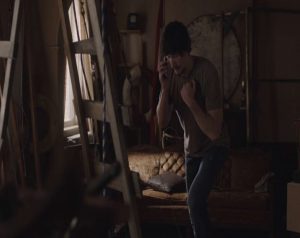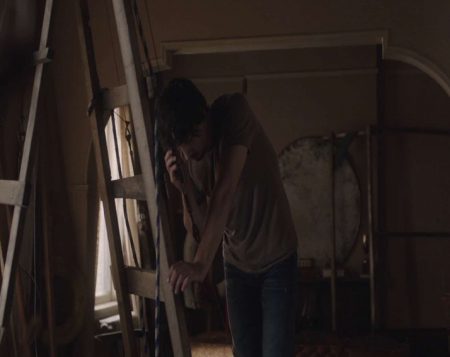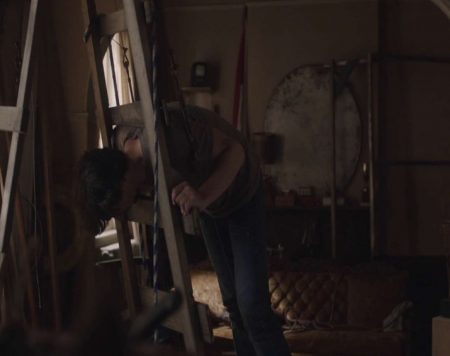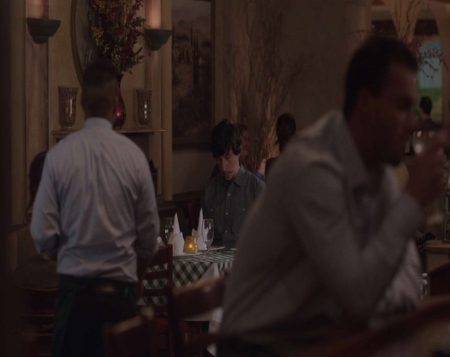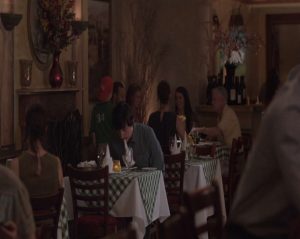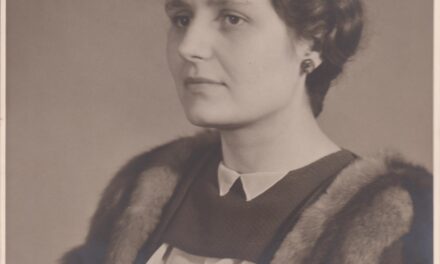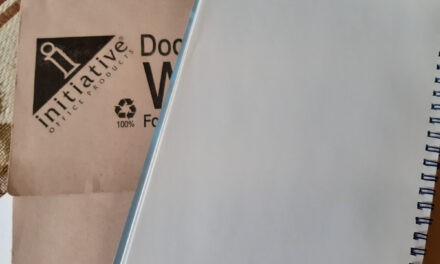Graduating from the Juilliard School as recently as 2009, Adam Driver is currently experiencing a seminal phase of his career with his mass exposure to a worldwide audience via Star Wars: The Force Awakens (J. J. Abrams, 2015). His breakthrough part has undoubtedly been Adam Sackler, ‘the sexually debased actor-carpenter-weirdo’ in Girls (HBO, 2012-present); a part for which he has received three Emmy nominations to date. Press and critical attention have been quite focused on his performance in Girls in terms of the ‘unpretty sex’ and related physical acts in which his character engages, as well as his striking physicality – Driver is 6ft 3in tall and has been described as having ‘a face like human origami’. This attention has generally sought to discursively understand and position the actor via notions of oddness[1] that inform his character on the programme. Somewhat wary of such discursive undertakings, because the close linking of actor to character risks of side-lining, if not diminishing, the actual work undertaken by an actor for a part, we want to give consideration to Adam Driver’s approach within Girls to a particularly interesting aspect of acting, namely the use of space and texture. We will focus our discussion on the episode ‘It’s Back’ (2.08), specifically the scene when Adam Sackler is on the phone with Natalia’s voicemail/Natalia, which occurs from 9.08 – 10.09 in the episode.
Set in Sackler’s apartment, which is strewn with carpentry-related items, this short scene consists of six shots and has Driver’s Adam leave a message on Natalia’s voicemail within the first two shots, before Natalia picks up and they agree to go on a blind date. The second shot is particularly rich: within the medium long shot, Driver delivers his voicemail message for Natalia whilst swaying sideways as though limbering up, leaning gingerly forward and climbing on a makeshift workbench, resting against a ladder on the workbench with his left hand, and finally sticking his head through the ladder. With the camera held at a distance, stationary except for slight tilting to follow his upward and downward trajectory, the emphasis of the framing lies on capturing him as he moves through the living room of the apartment, very much enabling him to explore the space as he wishes. Indeed, with the relative stillness of the camera and the lighting coming from the window to the left of the screen and contouring the right side of his body, Driver’s movements are accentuated within the shot.
Adam leans forward and climbs on the workbench, following the movement of his left elbow
What this particular rendering of the shot brings out is, once again within our blog strand, a somewhat performative quality (see, for example, our examinations of Robert Lindsay in G.B.H.(Channel 4, 1991) and Charles Dance in Game of Thrones (HBO, 2011-present)): Driver’s character at the start here is very much loosening up like one might do before a performance, be it for theatre or sport. Both of these similes seem apt here, for Driver’s Adam has to manage delivering an answerphone message for a potential blind date; as much a verbal performance as it surely is an excruciating test of endurance, especially for a character who does not fit easily into societal/behavioural norms. The performative aspect of the scene is further developed through the fact that the bulk of the message is delivered by Adam on the stage-like workbench, and that he ends the phone conversation by bending forward, similar to a stage actor’s bow or an athlete’s exhausted slump at the end of their respective performances.
However, what interests us here more is that Driver’s Adam, haltingly delivering his lines to indicate that his character is preoccupied with his own internal monologue and struggling with what to say, is engaging with space in a particular way. By space, we here mean both the space of and immediately surrounding his body, as well as the wider space of the apartment. Driver bends sideways, loosening up and feeling his muscles and joints, thereby bringing his physicality to the foreground. He develops this by somewhat following the swerve of his left arm as he bends forward and climbs on the workbench, before resting heavily on his left hand on the ladder and sticking his head between the second and third rung of the ladder; a height that is noticeably low for his 6ft 3in frame. What these choices – the swaying from side to side, the forward momentum by the left arm, the weight put on the ladder and the awkward height for his head – bring out is a sense of his character really being in that space, and an embodied experience of being in the world.
With the emphasis on the sensory and corporeal, what Driver does links, of course, closely to the relationship between acting and phenomenology. Daniel Johnston has argued with particular reference to Stanislavskian approaches to acting that ‘phenomenology and acting might be constructively thought of as mutually informing discourses.’ (2011, 66) As he elaborates:
Notwithstanding the absence of phenomenological terminology, Stanislavski is detailing an acting process that requires an embodied understanding of the way that the world presents itself to human consciousness in its rich, lived experience. This understanding is developed not for its own sake but rather to produce controlled artistic presentation on stage, while avoiding the inconsistencies of an untrained intuition. In this sense, the actor’s art can be seen as an embodied philosophy that makes different ways of “being-in-the-world” manifest and, ultimately, gestures toward the “meaning of being”. (ibid., 65)
Our intention here is, of course, not to enter into an in-depth discussion of the relationship between acting and phenomenology, but to note that Driver’s performance as Sackler is hinged around the centrality of the lived body and embodied experience that have been highlighted in the seminal writing of Maurice Merleau-Ponty (2002). It is especially his sticking of his head through the ladder that links to Konstantin Stanislavski’s (albeit implicit) phenomenological insistence that ‘[i]n every action there is something psychological, and in the psychological, something physical’ (1989, 258): the physical act of sticking his head through the ladder not only calls up a vivid sense of being in the world and lived experience of space, but also links to character psychology and characterisation in the way in which it invokes the image of a guillotine as Driver’s character hits the peak of his struggles with his verbal performance on Natalia’s voicemail.
Crucially, Driver highlights the phenomenological, embodied experience of being in the world through paying attention to space and particularly the texture of the space. Texture has been insightfully discussed by Lucy Fife Donaldson in relation to film, who examines it in depth in relation to the tactile, sensuous properties of audio-visual materiality present within a film as well as ‘the orchestration or interrelationship of the various audiovisual strands’ (2014, 40) of a film. Fife Donaldson rightly points out that texture in film:
concerns the fine detail and materiality of the film’s design, texture experienced within the visual style of the film, the qualities of material chosen for their function and expressivity. Texture in film is shaped through details of production design, costuming, make-up, sound design, all of which determine the look and feel of surfaces, decor and bodies. (ibid., 37)
Building on Fife Donaldson’s work, which is mindful of the importance of performance, and Alex Clayton’s writing on the texture of performance, with which we share the interest in ‘the fine detail of what is offered by actors to microphone and camera, and the manner in which that work is woven into the fabric of the film’ (2011, 78), we would like to emphasise that texture deserves attention in relation to the processes of acting and the practitioner’s perspective.
Driver has clearly paid attention to the textures of the space available to him, both vertically and horizontally. For him, the apartment is not a ‘shell’ within which to deliver his lines and execute his actions, but a materiality to be explored and interacted with (almost as a character in itself): the available free space/air is to be swayed and bent through, the precarious workbench (a pallet on a crate) is to be climbed on, the wooden ladder is to be rested against, and the evenly spaced rungs in the ladder provide holes that one can (and therefore, in some ways, must) stick something through. (The timing of Driver’s engagement with these spatial objects shows the carefulness of his attention to textures of space during rehearsal: his head is fully through the ladder when his call switches from voicemail message to ‘live’ phone conversation.) These textures provide a kind of obstacle course for him to master, allowing him to feel the textures of his physicality – his joints and muscles, his weight, his height – in turn.
Driver pays attention to texture and takes up texture’s implicit invitation to explore and experience it sensorily on numerous other occasions in Girls, including a brief moment a little later in the episode (13.04-13.19) when he is in a restaurant, waiting for Natalia’s arrival. Now in a public place with certain codes and conventions for the use of space, he stays seated, but, looking fixedly at the napkin on his placemat, eventually leans forward and picks it up with his teeth, dangling it from side to side, before releasing it back on the table. Perhaps what invited him to do this was the texture of the napkin: the weight of the cloth, the weave of the fabric, and the way it is folded into peaks – these qualities could make it attractive to turn the napkin into a pendulum. Certainly, the materiality of the napkin will have him feel his teeth, lips and neck (especially as he is now wearing a buttoned shirt), highlighting his physicality to him and the observant viewer. This moment of waiting would have been quite empty and conventional without this little, playful action by Driver, reinforcing Sackler’s characterisation – as a character not comfortable with social codes but currently trying to fit into them a little more (his action is, by his standards, rather restrained) – and also once more that sense of Heideggerian being-in-that-space (see Heidegger 1962).
Heideggerian being-in-that-space: Adam plays with the napkin
Our discussion, through its reference to actor agency, again touches on the issue of what is in the script and what is not, which we already considered in relation to Benedict Wong in Marco Polo(Netflix, 2014-present). It is worth adding here that the particular production context of Girls to some extent problematises the distinction of what is in the script and what the actor brings to the part, as the Girls script writing process has become increasingly influenced by the actor. Lena Dunham has commented in an interview with critic Alan Sepinwall: ‘And I think we’ve learned a lot from our actors. Adam (Driver) really informed who that character became because he played the role from his first audition with a kind of sweetness and oddity that we didn’t expect.’ Moreover, and similar to what we have already discussed in relation to Nurse Jackie, the writing, directing and acting on Girls form a productive symbiotic relationship that makes space for and welcomes the actors’ input and use of improvisation – as Vanessa Grigoriadis has noted on Vulture, ‘[o]n set, they generally filmed what Dunham had on the page but also tried some of his [Driver’s] suggestions’[2] – which further complicates issues of authorship and creative agency.
Nevertheless, with our focus on what actors do when they act, we are struck by the ways in which Adam Driver has significant input into Girls, not least because of his careful (although not necessarily conscious) approach to space and its textures. The oddness of his character Adam Sackler needs to be understood much less in terms of any oddness on the part of Adam Driver himself, and much more as reflecting the careful engagement by the actor with this role, who delivers an experiential embodied encounter with texture that uses space to bring space, and more, to life.
Gary Cassidy is currently undertaking AHRC-funded doctoral research at the University of Reading. His thesis explores the rehearsal process of playwright Anthony Neilson, using filmed footage of rehearsals and interviews. He trained as an actor at the Royal Scottish Academy of Music and Drama and has thirteen years of acting experience – Equity name Cas Harkins – covering film, theatre, television and radio. Plans for future research focus on using his research methodology to explore the working processes of other contemporary theatre practitioners.
Simone Knox is Lecturer in Film and Television at the University of Reading. Her research interests include the transnationalisation of film and television (including audio-visual translation), aesthetics and medium specificity (including convergence culture), and representations of the body. She sits on the board of editors for Critical Studies in Television and her publications include essays in Film Criticism, Journal of Popular Film and Television and New Review of Film and Television Studies.
Reference List
Clayton, Alex. 2011. ‘The Texture of Performance in Psycho and its Remake’. Movie: A Journal of Film Criticism 3: 73-79. Available here: http://www2.warwick.ac.uk/fac/arts/film/movie/contents/psycho_clayton.pdf.
Fife Donaldson, Lucy. 2014. Texture in Film. London: Palgrave Macmillan.
Heidegger, Martin. 1962. Being and Time. New York: Harper & Row.
Johnston, Daniel. 2011. ‘Stanislavskian Acting a Phenomenology in Practice’. Journal of Dramatic Theory and Criticism 26 (1): 65-84.
Merleau-Ponty, Maurice. 2002. Phenomenology of Perception. London and New York: Routledge.
Stanislavski, Konstantin. 1989. Sobranie sochinenii, vol. 2 [An Actor’s Work on Himself, Part 1]. Moscow: Iskusstvo.
Footnotes:
[1] See here and here as just two examples of this discursive framing.
[2] The ‘Guys on Girls’ DVD feature on the box set for the second season includes a discussion by Dunham, Driver and the rest of the main male cast on the use of improvisation within given parameters, with Driver noting the collaborative process and freedom to fail. Dunham mentions that Driver’s use of improvisation within his first audition triggered a rewriting of a number of scenes in the first season.


